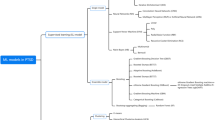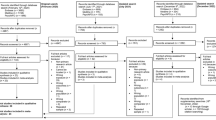Abstract
Purpose of Review
This review summarizes the increasing public health concern about PTSD and suicide, and the population-based studies that have examined this association. Further, we discuss methodological issues that provide important context for the examination of this association.
Recent Findings
The majority of epidemiologic studies have shown that PTSD is associated with an increased risk of suicide; however, a notable minority of studies have documented a decreased risk of suicide among persons with PTSD. Methodological (e.g., sample size and misclassification) and etiologic issues (e.g., complicated psychiatric comorbidity) may explain the conflicting evidence.
Summary
PTSD may be associated with an increased risk of suicide, but further research is needed. Increasing the use of appropriate methods (e.g., marginal structural models that can evaluate both confounding and effect modification, machine learning methods, quantification of systematic error) will strengthen the evidence base and advance our understanding.
Similar content being viewed by others
References
Papers of particular interest, published recently, have been highlighted as: • Of importance •• Of major importance
Power AK, McKeon R. Preventing suicide is a national imperative. Am J Public Health. 2012;102(Suppl 1):S7.
CDC. Vital signs 2018 [updated June 11, 2018. Available from: https://www.cdc.gov/vitalsigns/suicide/index.html.
WISQARS Years of Potential Life Lost (YPLL) Report, 1981 and 2016 Centers for disease control and prevention; [updated February 19, 2017. Available from: https://webappa.cdc.gov/sasweb/ncipc/ypll.html.
Reger MA, Smolenski DJ, Skopp NA, Metzger-Abamukang MJ, Kang HK, Bullman TA, et al. Risk of suicide among US military service members following Operation Enduring Freedom or Operation Iraqi Freedom deployment and separation from the US military. JAMA psychiatry. 2015;72(6):561–9.
Kuehn BM. Soldier suicide rates continue to rise: military, scientists work to stem the tide. JAMA. 2009;301(11):1111–3.
Program VSP. Facts about veterans suicide. In: Affairs DoV, editor. 2016.
SAMHSA. Critical issues facing veterans and military families 2017 [updated January 20, 2017. Available from: https://www.samhsa.gov/veterans-military-families/critical-issues.
Maris RW, Berman AL, Silverman MM. Introduction to the study of suicide. In: Comprehensive textbook of suicidology. New York: Guilford Press; 2000. p. 3–25.
Koven SG. PTSD and suicides among veterans—recent findings. Public Integrity. 2017;19(5):500–12.
Gradus JL. PTSD and death from suicide. PTSD Research Quarterly 2017;28(4).
Panagioti M, Gooding P, Tarrier N. Post-traumatic stress disorder and suicidal behavior: a narrative review. Clin Psychol Rev. 2009;29(6):471–82.
Krysinska K, Lester D. Post-traumatic stress disorder and suicide risk: a systematic review. Archives of Suicide Research. 2010;14(1):1–23.
• Hyman J, Ireland R, Frost L, Cottrell L. Suicide incidence and risk factors in an active duty US military population. Am J Public Health. 2012;102(S1):S138–S46. This study included the entire active duty military population in 2005 and 2007 and found that PTSD was associated with an increased risk of suicide among members of the Army and the Air Force; however, the effect of comorbid psychopathology was not considered.
Black SA, Gallway MS, Bell MR, Ritchie EC. Prevalence and risk factors associated with suicides of army soldiers 2001-2009. Mil Psychol. 2011;23(4):433–51.
Bachynski KE, Canham-Chervak M, Black SA, Dada EO, Millikan AM, Jones BH. Mental health risk factors for suicides in the US Army, 2007–8. Injury Prevention 2012:injuryprev-2011-040112.
• LeardMann CA, Powell TM, Smith TC, Bell MR, Smith B, Boyko EJ, et al. Risk factors associated with suicide in current and former US military personnel. JAMA. 2013;310:496–560. This study used data from the Millenium Cohort Study to examine risk factors for suicide. Although PTSD was associated with an increased risk of suicide in unadjustment and age and sex adjusted models, the authors did not include it in the multivarite adjusted models because this association was not statistically significant.
O’Donnell ML, Creamer M, Pattison P. Posttraumatic stress disorder and depression following trauma: understanding comorbidity. Am J Psychiatry. 2004;161(8):1390–6.
Gradus JL. Prevalence and prognosis of stress disorders: a review of the epidemiologic literature. Clin Epidemiol. 2017;9:251–60.
• Shen Y-C, Cunha JM, Williams TV. Time-varying associations of suicide with deployments, mental health conditions, and stressful life events among current and former US military personnel: a retrospective multivariate analysis. The Lancet Psychiatry. 2016;3(11):1039–48. In this study of all military personnel from 2001 through 2011, PTSD was associated with a decreased risk of death from suicide, after adjustment for psychiatric comorbidity, across all time intervals examined.
Bullman TA, Kang HK. Posttraumatic stress disorder and the risk of traumatic deaths among Vietnam veterans. J Nerv Ment Dis. 1994;182(11):604–10.
•• Ilgen MA, Bohnert ASB, Ignacio RV, McCarthy JF, Valenstein MM, Kim HM, et al. Psychiatric diagnoses and risk of suicide in veterans. Arch Gen Psychiatry. 2010;67(11):1152–8. This study documented associations between many psychiatric diagnoses, including PTSD, and suicide in the full population of patients who received treatment at the VA in fiscal year 1999.
Ilgen MA, McCarthy JF, Ignacio RV, Bohnert ASB, Valenstein M, Blow FC, et al. Psychopathology, Iraq and Afghanistan service, and suicide among Veterans Health Administration patients. J Consult Clin Psychol. 2012;80:323–30.
• Conner KR, Bossarte R, Lu N, Bohnert ASB, McCarthy JF, Ignacio RV, et al. Mental disorder comorbidity and suicide among 2.96 million men receiving care in the Veterans Health Administration system. J Abnorm Psychol. 2013;122(1):256–63. This study, of all VA patients in fiscal year 1999, found that persons with PTSD and no comorbid diagnoses had 1.6 times the rate of suicide than persons without PTSD.
•• Conner KR, Bossarte RM, He H, Arora J, Lu N, Tu XM, et al. Posttraumatic stress disorder and suicide in 5.9 million individuals receiving care in the Veterans Health Administration system. J Affect Disord. 2014;166:1–5. This paper documented an increased risk of suicide among persons with PTSD in a sample of all patients who received VA care in fiscal year 2007. After adjustment for other psychiatric diagnoses, however, results showed that PTSD was associated with a decreased risk of suicide.
Desai RA, Dausey D, Rosenheck RA. Suicide among discharged psychiatric inpatients in the Department of Veterans Affairs. Mil Med. 2008;173(8):721–8.
Britton PC, Bohnert KM, Ilgen MA, Kane C, Stephens B, Pigeon WR. Suicide mortality among male veterans discharged from Veterans Health Administration acute psychiatric units from 2005 to 2010. Soc Psychiatry Psychiatr Epidemiol 2017 1–7.
•• Zivin K, Kim HM, McCarthy JF, Austin KL, Hoggatt KJ, Walters H, et al. Suicide mortality among individuals receiving treatment for depression in the Veterans Affairs health system: associations with patient and treatment setting characteristics. Am J Public Health. 2007;97(12):2193–8. This study is frequently cited as evidence that PTSD is associated with a decreased risk of death from suicide.
•• Bullman T, Schneiderman A, Gradus JL. Relative importance of posttraumatic stress disorder and depression in predicting risk of suicide among a cohort of Vietnam veterans. Suicide and Life-Threatening Behavior. 2018. This study examined PTSD and depression as predictors of death from suicide among veterans, and demonstrated that PTSD is associated with an increased risk of suicide, but when the refernt group is changed to persons with depression, it appears that PTSD is associated with a decreased risk of suicide.
Gradus JL, Qin P, Lincoln AK, Miller M, Lawler E, Sørensen HT, et al. Posttraumatic stress disorder and completed suicide. Am J Epidemiol. 2010;171(6):721–7.
•• Gradus JL, Antonsen S, Svensson E, Lash TL, Resick PA, Hansen JG. Trauma, comorbidity, and mortality following diagnoses of severe stress and adjustment disorders: a nationwide cohort study. Am J Epidemiol. 2015(182):451–8. This is the largest general population study to date to document an association between PTSD and death from suicide.
Rothman KJ, Greenland S, Lash TL. Validity in epidemiologic studies. 3rd edition. Philadelphia: Lippincott, Williams and Wilkins; 2008.
CDC. Health, United States, 2016. National Center for Health Statistics; 2016.
Mooney SJ, Westreich DJ, El-Sayed AM. Epidemiology in the era of big data. Epidemiology (Cambridge, Mass). 2015;26(3):390–4.
Khoury MJ. Planning for the future of epidemiology in the era of big data and precision medicine. Am J Epidemiol. 2015;182(12):977–9.
Rockett IR. Counting suicides and making suicide count as a public health problem. Hogrefe Publishing 2010.
Rockett IR, Samora JB, Coben JH. The black–white suicide paradox: possible effects of misclassification. Soc Sci Med. 2006;63(8):2165–75.
Lash TL, Fox MP, Fink AK. Applying quantitative bias analysis to epidemiologic data. New York: Springer; 2009.
Greenland S, Lash TL. Bias Analysis. In: Rothman KJ, Greenland S, Lash TL, editors. Modern epidemiology. 3rd ed. Philadelphia: Lippincott, Williams & Wilkins; 2008. p. 345–80.
Author information
Authors and Affiliations
Corresponding author
Ethics declarations
Conflict of Interest
Jaimie L. Gradus declares that she has no conflicts of interest.
Human and Animal Rights and Informed Consent
This article does not contain any studies with human or animal subjects performed by any of the authors.
Additional information
This article is part of the Topical Collection on Disaster Psychiatry: Trauma, PTSD, and Related Disorders
Rights and permissions
About this article
Cite this article
Gradus, J.L. Posttraumatic Stress Disorder and Death From Suicide. Curr Psychiatry Rep 20, 98 (2018). https://doi.org/10.1007/s11920-018-0965-0
Published:
DOI: https://doi.org/10.1007/s11920-018-0965-0




